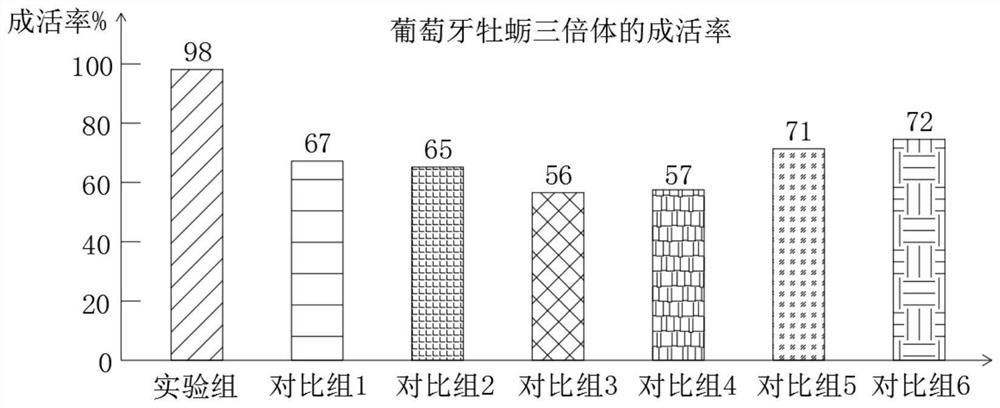Artificial seedling breeding technology for Portuguese oyster triploid
A Portuguese oyster and triploid technology, applied in the field of soil remediation, can solve the problems of unable to meet the needs of users, affect the large-scale cultivation of Portuguese oyster triploid, and the low survival rate of Portuguese oyster triploid, and achieve excellent survival rate, The effect of reducing the cost of cultivation and wide application prospects
- Summary
- Abstract
- Description
- Claims
- Application Information
AI Technical Summary
Problems solved by technology
Method used
Image
Examples
Embodiment 1
[0024] Example 1: cultivation of tetraploidy and Diploidium of the Portuguese oyster
[0025] (1) Cultivation of tetraploidy of long oysters
[0026] Take 6-10 cm of unscathed 2-year pure oyster tetraploidy, and select male individuals from the tetraploidy of purebred oysters; Male individuals are placed in the culture tank, and male individuals are provided with temporary salinity of 16-18, temporary breeding temperature of 24-26 ° C, male individuals are bred, during the breeding period, in accordance with the conventional breeding method, monocytobacterial bait is released every day, and the daily amount of bait is 400,000-600,000 / ml;
[0027] (2) Cultivation of diploids of Portuguese oysters
[0028] Female individuals were selected from the diploids of Portuguese oysters over 3 years of age without damage, and then female individuals with a size of 7-8 cm were selected, and the female individuals were placed in the culture tank, and cultivated under the conditions of tempor...
Embodiment 2
[0029] Example 2: Portuguese oyster triploid of the present invention is obtained
[0030] (1) Using artificial dissection, the eggs are removed from the female individuals of the cultivated Portuguese oyster diploid, and filtered with 100 mesh and 200 mesh sieves, respectively, and then filtered with 500 mesh sieves, and then from the male individual tetraploid tetraploid of the long oyster, the sperm is removed, and the sperm is filtered with a 500 mesh sieve silk;
[0031] (2) Observe the sperm under the microscope, select the lively sperm, add the sperm to the egg fluid, and ensure that the ratio of male and female is 30:1, mix sperm and eggs, complete the hybridization of eggs and sperm, that is, complete the fertilization of eggs;
[0032](3) The fertilized eggs are incubated after 20-24h to form D-shaped larvae, and the larvae are selected with a 300 mesh sieve silk to obtain high-quality and robust larvae;
[0033] (4) The preferred larvae are bred into juvenile shells und...
Embodiment 3
[0035] Example 3: Effect of different temperatures on triploid cultivation of Portuguese oysters
[0036] The temporary salinity of the tetraploid cultivation of long oysters is 17, the temporary temperature is 25 °C, the temporary salinity of the Portuguese oyster diploid is 21, the temporary temperature is 25 °C, and then the excellent larvae are cultivated under the condition of salinity of 23 and water temperature of 30 °C, according to the cultivation method of Example 1 and Example 2, 1000 Portuguese oyster triploids are cultivated, as an experimental group, under other conditions remain unchanged, the temporary rearing temperature of the long oyster tetraploid cultivation is 20 °C and 28 °C. Each breeding 1000 Portuguese oyster triploids, as a comparison group 1 and a comparison group 2, other conditions unchanged, the Portuguese oyster diploid cultivation of the temporary rearing temperature of 22 °C and 28 °C, each cultivated 1000 Portuguese oyster triploid, as a comparis...
PUM
 Login to View More
Login to View More Abstract
Description
Claims
Application Information
 Login to View More
Login to View More - R&D
- Intellectual Property
- Life Sciences
- Materials
- Tech Scout
- Unparalleled Data Quality
- Higher Quality Content
- 60% Fewer Hallucinations
Browse by: Latest US Patents, China's latest patents, Technical Efficacy Thesaurus, Application Domain, Technology Topic, Popular Technical Reports.
© 2025 PatSnap. All rights reserved.Legal|Privacy policy|Modern Slavery Act Transparency Statement|Sitemap|About US| Contact US: help@patsnap.com



